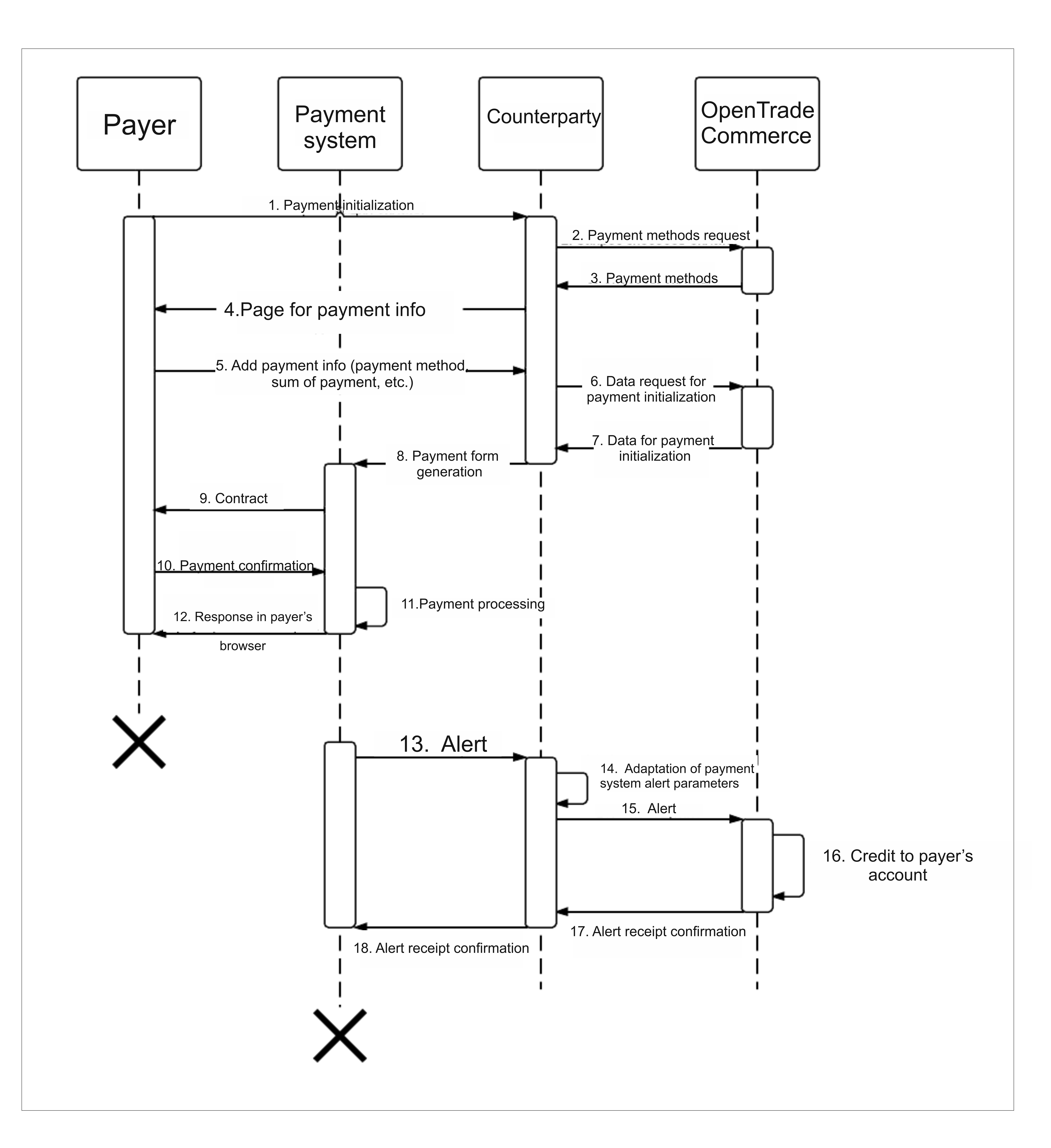1.Issues under consideration
If you do not find a payment system in the list of available ones, you can set up any other payment system using the OpenTrade Commerce services interaction protocol.
2.Overview
OpenTradeCommerce provides a protocol that enables the contractor to integrate payments methods unavailable to OpenTradeCommerce customers into the order and funds flow management system.
Terminology
“OpenTrade Commerce” means an order and funds flow management system. Billing.
“Contractor” means an OpenTradeCommerce customer.
“Payer” means a contractor’s Web-resource user that makes a payment.
“PS” means a payment system.
Setup
In order to set up a payment system using a protocol provided you will need to:
Be an OpenTradeCommerce customer
Submit a service request for custom PS integration to OpenTrade Commerce technical support
Receive a payment secret (3.3.1). Subsequently the contractor is responsible for protecting information from disclosure.
3. General protocol description
A flowchart of interaction of all parties involved in payment process
The interaction process is a generalized example. There is a certain amount of flexibility in how these phases are implemented and when they occur in real-life situations of interaction.
Below is the step-by-step description of interaction process.
3.1. An example of interaction between Payer, Payment System, Contractor and OpenTrade Commerce when making payment.
Step 1. The payer initiates the payment process.
Step 2-4. The contractor’s website will ask OpenTrade Commerce for payment methods using the GetPaymentModes method and show them to the payer.
In response the GetPayment Modes method will return the following identifier for a payment method intended for a custom PS : opentao.custom.
Step 5. The payer will then select a payment method and enter payment data such as amount of payment, etc.
Step 6. The contractor’s website will request OpenTrade Commerce accounting information to initiate a payment through PS using the GetPaymentParameters method.
Step 7. OpenTrade Commerce will send back the payment data in response to the GetPaymentParameters method invocation.
Step 8. The contractor will generate a payment form in accordance with the payment system requirements on the basis of the data provided in Step 7.
Step 9. After you have provided all the required data by filling out the form the payment system will form a contract, send it to the payer and ask to confirm the payment.
Step 10. The payer will confirm the payment.
Step 11. The payment system will accept and verify the payment.
Step 12. The payment system will return a response to the payer’s browser with the result of the payment (successful/failed).
3.2. An example of interaction between Payment System, Contractor and OpenTrade Commerce when notifying a customer about payment.
Step 13. The payment system notifies the contractor of completed payment.
Step 14. The contractor will adapt the data provided in Step 13 so that they match the OpenTrade Commerce notification parameters.
Step 15. The contractor will notify OpenTrade Commerce of the completed payment.
Step 16. OpenTrade Commerce will verify the notification parameters. If everything checks out and the payment status is considered “Completed”, OpenTrade Commerce will enter a sum to the payer’s account.
Step 17. OpenTrade Commerce will confirm the contractor that the payment notification has been received.
Step 18. The contractor will confirm the PS that the payment notification has been received
3.3 Tables
3.3.1 Payment parameters
Parameter | Description | Allowed Values | Note |
|---|---|---|---|
Instancekey | Unique ID identifying contractor |
|
|
secret | Payment secret |
| Required for creation of a digital signature 3.4. Provided to the Contractor by Opentrade Commerce |
orderId | Unique ID identifying order for payment |
| Available if a customer pays for an order Unavailable when replenishing |
paymentId | Unique ID identifying payment at OpenTrade Commerce internal billing system |
|
|
userId | Unique ID identifying OpenTrade Commerce user |
|
|
Amount | Amount of payment |
| The point as a decimal mark and two digits after it |
Currency | ISO 4217 (3-letter currency code) | 643 - RUB | |
Status | Payment status | Completed
Canceled |
|
Signature | MD5-hash of digital signature |
| 32 hexadecimal uppercase symbols |
description | Payment description |
|
|
3.3.2 NoticeErrorCode description
Code | Description |
|---|---|
OK | A notification has been processed. |
VerificationError | Incoming data verification error |
SignatureVerificationError | There is a mismatch between the digital signature received from the contractor and the one calculated by OpenTrade Commerce
|
InternalError | OpenTrade Commerce service internal error. Unhandled error |
3.4.Rules for elaborating a digital signature when the contractor notifies Opentrade Commerce
The MD5-hash algorithm is applied to a text represented as a sequence of parameter values separated by semicolon.
| Orderld; paymentld; amount; currency; status; secret |
Example:
String | Result |
111;222;0000000001;500.15;643;Completed;secret | 11AE0ABC8F0CF443F950D84C278F1C51 |

